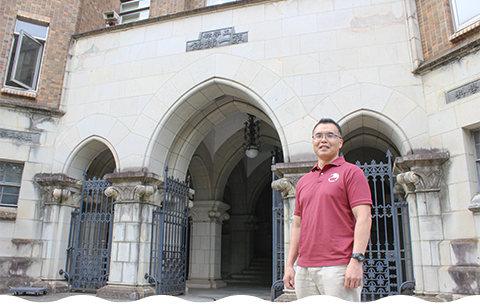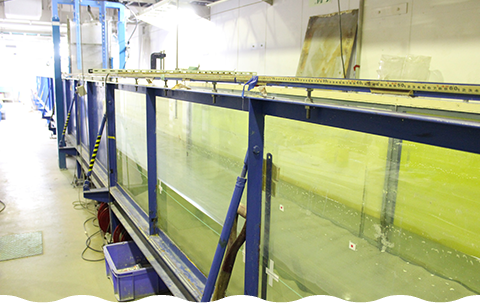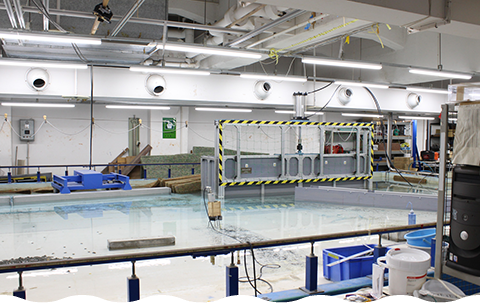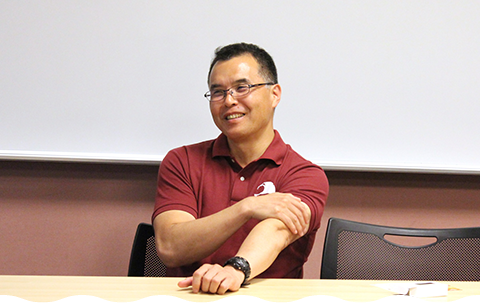
A. Coastal engineering covers various phenomena around the coast, such as predictions of waves, currents, and the resulting coastal topography changes, all of which are essential for preservation and protection of coast, as well as for protection of coastal inland areas from various coastal hazards such as high waves, storm surges, and tsunamis. In addition, with the increasing emphasis placed on environmental conservation, the coastal engineering also covers a broad range of other research topics, such as development of various techniques for coastal environmental assessment, as well as for estimation of wave forces required for designing harbors and coastal structures.
A. It is simply because I like the ocean. I grew up near the coast mostly in Chigasaki and three years in Yokosuka. I have been interested in buildings and structures related to architecture and civil engineering, which inclined me to engineering-related academic disciplines. I was particularly attracted to relatively large-scale structures, and together with my interest in civil engineering and architecture, this led me down the path of coastal engineering.


A. Unlike the offshore sea away from the coast, the nearshore sea has relatively shallow water depth, where we see dynamic changes of waves, currents, and coastal topography. My research focuses on elucidating the mechanism of such dynamic behavior of waves, currents, and coastal topography in nearshore areas. We also work on understanding and modeling of propagation, deformation and inland inundation of tsunamis, storm surges, and high waves. We also conduct various field surveys after the severe coastal disasters, from which we often find unique phenomena that we have rarely experienced. We also explores physical mechanisms of such rare phenomena based on field survey data and supplemental laboratory experiments and numerical simulations. Understandings and predictions of these rare phenomena is essential for future coastal protection and disaster mitigation measures. Recently, video footage recorded in various locations enable us to observe such rare phenomena, which is very useful in our research.
A. These islands are very important in the field of coastal engineering. Coastal conservation and protection is one of most important tasks of coastal engineering. Conservation of remote territorial islands is of particular importance, but is a challenging task because these remote islands are exposed to severe waves and have a limited supply of sand and gravel which form beaches. Recently, many students show their interests in research topics related to conservation and protection of remote islands, including Okinotorishima Island and Minamitorishima Island. We also expect that the research related to conservation of these remote islands will also contribute to improving coastal protection and conservation techniques for overseas islands.
 〈 The 2D wave flume in the Coastal Engineering Laboratory on campus (upper) The plane wave basin and the dam-break-wave generator (lower) 〉
〈 The 2D wave flume in the Coastal Engineering Laboratory on campus (upper) The plane wave basin and the dam-break-wave generator (lower) 〉
>> Click here to view the interview with Professor Kayanne.
A. I joined this research project partially because I had been working with Professor Kayanne on the research related to the preservation and conservation of coral reef coasts. Okinotorishima Island and Minamitorishima Island are also important sites for this research theme. Paticullaly, Okinotorishima Island may be vulnerable to future sea level rise and erosion. Professor Kayanne has worked on restoration of corals that should contribute to conservation of coral reef and coast. An engineering-based approach is important in order to properly evaluate the effects of coral restoration on coastal protection and conservation. I was involved in this project to conduct such engineering-based studies.
A. We share the survey tasks so as to make the best use of our different expertise. Professor Kayanne conducts research related to coral cultivation and restoration. He evaluates the growth rate of corals and to what extent such growth can catch up with the future sea level rise.
My task is to conduct engineering-based analyses based on the data and findings provided by Professor Kayanne to evaluate how the coral growth contributes to the coastal protection and conservation. These findings will then be applied to planning and design of nature-based coastal protection and conservation measures through coral restoration.

A. I went there in January. I had heard from persons who had been there before that severe seasick may keep me stuck in my cabin and force me to sleep with a bucket in my arms. While it was not as bad as I anticipated, it was still a harsh trip. On the other hand, since I was on board for so long with no internet connection, I was able to enjoy my off-line personal time. It was good to stay away from my daily works and to spend some time at my own pace.
 〈 In a conference room in Faculty of Engineering Bldg.1, The University of Tokyo 〉
〈 In a conference room in Faculty of Engineering Bldg.1, The University of Tokyo 〉
A. We stayed around Okinotorishima for five days. I did not feel a big gap between the actual island and my images I had before the visit from pictures and other related documents. Even so, it was still very interesting to see that the amount of coral gravel and sediments on the reef was much more than I had imagined. As a coastal engineer, I dream that the coral gravels and sediments will naturally accumulate and grow the island as a result of some intervention of coral restoration and engineering approach to control waves, currents and sediment transport characteristics. In this sense, it was very encouraging to see such a large amount of coral gravel and sediments on and around the island.
A. Most people may imagine Tokyo Bay when they think of the sea around Tokyo, but once you get out into the open sea, the scenery and wave conditions are completely different. Japan’s territorial waters play a very important role in our lives, and both Okinotorishima Island and Minamitorishima Island are parts of this. I hope that the coastal engineering will contribute to coastal protection and conservation, preservation of biodiversity and ecosystems, and to water quality control under various severe coastal conditions. At the same time, recent innovative technologies enable us to get various data that had not been available. I hope that integration of these data will enable us to evaluate the various values of coastal protection and conservation from different view points.